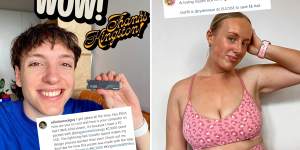But women and Gen Z content creators are earning significantly less than their male and Millennial counterparts, of 500 Australian influencers,commissioned by online design and printing service Vista.

Influencers @elliotisacoolguy and @elloise_fit feature sponsored content on their social media feeds.Supplied
While men take home an average of $56,738 a year from their social media posting,the average income of women creators is just $48,968. And the earnings divide is deepened over generations:Gen Z influencers pocket $20,000 less than their Millennial counterparts ($37,236 compared to $58,321).
The disparity across genders and generations is reflective of the makeup of creator economy in Australia,said Taryn Williams,founder and chief executive of marketing group theright.fit.
“There are generally fewer male[influencers],” she said. “So they can command higher fees purely because there are not as many of them available for brands to work with.”
One such man is Elliot Ulm,,a graphic designer who never expected to call himself an influencer.
Brands are shifting to platforms like influencer marketing,where they can get access to first-party data.
Taryn Williams
“I was doing a bit of graphic design work,” he said. “But I wasn’t having much luck finding clients,mainly because I didn’t have any work to show.”
“I just started posting[in 2019],I tried to combine my love for performing in comedy with my love for graphic design. I tried to mix the two together ... and people started to really like it.”
He started featuring a small amount of sponsored content on his Instagram page “as just a bit of extra money” while working in retail at Optus. But now edging toward 200,000 followers,the money he takes home from sponsored content and royalties from his print and phone case merchandise amounts to more than he would receive from a regular full-time job.
Despite TikTok being an unnatural platform for graphic design,Ulm has joined the platform to further his reach. It’s a well-advised move:TikTok creators earned more than any other platform ($71,000 compared to YouTube,on $67,000).

Influencers @elliotisacoolguyand @elloise_fit say they never expected to take home an income from Instagram and TikTok.Supplied
Like the slim majority of influencers (53 per cent),Ulm operates as a sole trader. But he is joined by influencers such as body-positive influencer Elloise Mary,,who say they would like more training in how to structure their financial operations.
“A lot of brands don’t want to pay,” said Mary,who advertises activewear,supplements and meal kits to her 25,000 followers,while working full-time in customer service.
She wants brands,and audiences,to understand that sponsored posts take far more time to produce than might be expected.
“It’s not as easy as just taking a photo,” she said. “It’s worthwhile for brands to start paying their creators because then they have the resources to put in more effort and create better content as well.”
And influencers are becoming increasingly important to brands to connect with audiences who are no longer easily accessible online,The Influencer Agency’s Williams said.
“iOS privacy changes meant that some online advertisers,Facebook particularly,were not as effective as they were previously,” she said.
“Brands are shifting to platforms like influencer marketing,where they can get access to first-party data and be much more accurate in how they reach consumers.”
Instead of targeting audiences with specific interests (for example,baby formula) on platforms like Facebook,marketers can partner with an influencer with a similar audience (such as parents).
“It means that I can get very,very specific and granular,which means much more effective advertising.”
The Business Briefing newsletter delivers major stories,exclusive coverage and expert opinion..